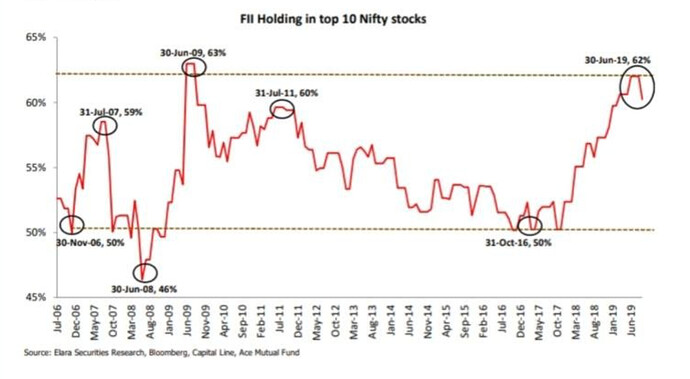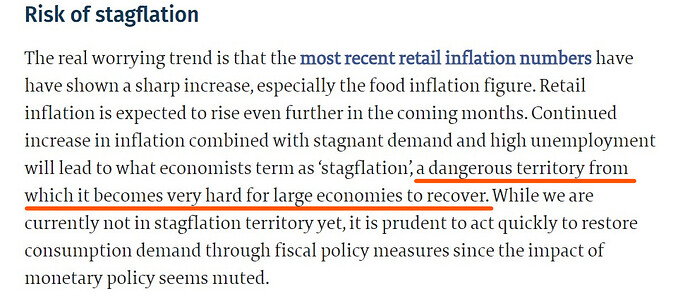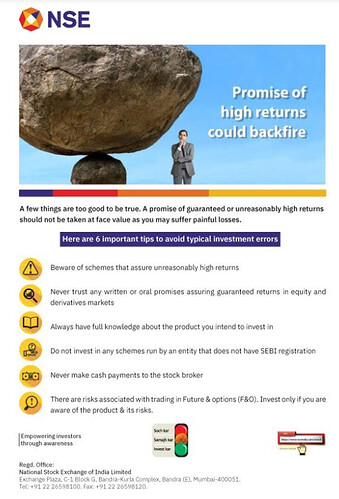FII holding in top 10 nifty stocks has reached historical level. Last time it peaked around 61% in 2009
Ray Dalio’s Work is unparalleled but he got broke in late nineties but he correctly predicted the bubble of 2007 , the below video is an excellent work from him It is 6 year old … but it add value
I want to edit this I have found a website from where you can access almost all the leading newspapers of the world free http://www.onlinenewspapers.com/
SSRN-id219228.pdf (261.4 KB)
This is a research report titled, Trading Is Hazardous to Your Wealth:
The Common Stock Investment Performance
of Individual Investors by
BRAD M. BARBER and TERRANCE ODEAN.
This studies over 65,000 portfolios held on the accounts of a large discount brokerage in US over a six year period ending in January 1997. Even though there is enough study done on different mutual funds, research done on individual portfolios probably is rare and that makes this research unique.
The study concludes that those who traded frequently were able to get average returns of around 11% while buy and hold portfolio earned around 18% on an average.
A very educational piece from our former PM / former FM / former RBI Guv who explains in some detail why we are currently suffering from slow growth. He was the turnaround architect of the Indian economy in 1991 and knows / has experienced the economy far more than anyone in the establishment. He speaks little and I realized I have ignored him often only to realize I am wrong.
There is, I suspect, an increasing risk that policy makers are taking India’s economic growth for granted and low GDP growth as an aberration that will soon correct itself. That is a mistaken assumption and is proving so every passing year.
The following paragraph is especially important:
Thanks @diffsoft for pointing to this nice article. As I work in SME space for a living, can definitely correlate to most of what Dr. Singh is saying. More than GDP growth and other data, what i find most worrying is - lack of animal spirit in SME space, these guys used to be eternal optimists, but now it seems everyone is risk averse. GST has really increased the regulatory compliance time a business need to spend, that could have been used productively elsewhere.
The only point of disagreement is that if this trend continues, India is not going towards stagflation, it is going towards deflation. Even now if you analyze the marketing schemes and price of a company, it seems they are not doing it increase sales or profitability. They are just liquidating stocks, sometimes even at a loss, to increase cashflow.
Food inflation always moves in a cycle in India and this cycle has an unusually high amplitude due to lack of proper storage and distribution infrastructure. In a couple of months, high vegetable price news would turn into distressed sale by farmers news. All govts past and present, including the one that was headed by Dr Singh, continuously talked about it. But no one ever strived hard to create a holistic solution to this problem. May be, being fatalistic is a cultural thing for us.
I think it is generally clear to me that demonetisation and a complicated GST has damaged SME sector substantially. Since the new GDP computation technique places more reliance on MCA data, this does not get captured. Consequently this gets into the GDP figures only when the organised sector gets impacted by the fall in SME.
At this rate we run a very high risk of making this GDP growth a new normal, because (a) investment rates have been falling, over the past 4-5 and are now led by the Govt - which has its limits. Falling investment rates will crimp near to mid term production and hence consumption impacting GDP, and further (b) household savings, the biggest funder for investment has fallen substantially over the same period, thus making traditional source of investment funding difficult. With falling GDP, and falling tax receipts growth, the Govt which is leading investment, has been relying substantially on non recurring sources of revenue like divestments and one-time big dividends of PSUs. This cannot go on, and that will put further pressure on investment rates thus decelerating GDP growth. Further, even after a fall in the ₹ by 20% over the past 5 years, our merchandise exports are not going up and overall exports have fallen from ~ 24% of GDP to under 20% in FY 19. Services exports have been slowing at a rapid pace because of IT slowdown, tougher H1B, and competition from other countries. So there does not seem to be an export engine to fuel growth. This will have an indirect pressure also on imports and thus on crude imports and thus on growth. We now import ~ 83% of our crude compared to ~ 75% say in 2006, and our domestic production is flat and India owned foreign oil assets have immaterial production. We cannot grow without consuming crude oil. This leaves FDI / FPI as the provider of capital, along with net remittances. Net FDI is generally flat at $ 30 billion or ~ ₹ 210,000 cr and net FPI is too fickle and can be expected at $ 10 billion or ~ 70,000 crores. Gross remittances grows steadily, but LRS outward remittances have seen a dramatic increase as well.
With this backdrop, if we have to increase investment rate by even 1% additionally from normal, we need, at FY 19 GDP, about ₹ 200,000 crores additionally, or about $ 30 billion. This is very unlikely to happen from domestic sources as seen above, and FDI / FPI cannot bring in that kind of money based on trendlines, maybe NRIs can be asked via remittances, but at our base the ask is too large. A multilateral / bilateral trade deal I thought to spur exports would have been great, but looks like we are far from it, the way we suddenly pulled out of RCEP.
So the natural conclusion is that we have to suffer slow growth for a while, but I would not be fatalistic ![]() . We managed 1991 when the economy was transformed nearly overnight, ₹ devalued substantially, competition brought in suddenly. Indian enterprises rose up to the challenge when they were unshackled. They will again, if unshackled from what Dr Singh talks about, and should happen some day, though can’t see it in the foreseeable near term.
. We managed 1991 when the economy was transformed nearly overnight, ₹ devalued substantially, competition brought in suddenly. Indian enterprises rose up to the challenge when they were unshackled. They will again, if unshackled from what Dr Singh talks about, and should happen some day, though can’t see it in the foreseeable near term.
Hi, by 61% do you mean that FIIs have an average of 61% holding in these 10 stocks?
No. Total FII exposure (weightage) is at peak level which is at 61%, similar to they had in 2009.
That article is just too pessimistic. It paints the entire economic growth of the country, since 91 reforms, as some kind of bubble. While I do agree the picture is not as rosy as the present govt. likes to paint but it is not that gloomy either.
Web Resource :
if one wants to find out the content n the warning letter issued by FDA one can search in below link
https://www.fda.gov/inspections-compliance-enforcement-and-criminal-investigations/compliance-actions-and-activities/warning-letters
The attached file contains links to 400 podcasts of Q2 earnings call arranged industry wise.
WeekendPodcastQ2FY20_1.pdf (1.3 MB)
Ideal for weekend listening.
Tweetstorm by Jatin Khemani. Thanks for the golden nuggets.
Source: https://twitter.com/jatin_khemani/status/1198596858773307397
A thread. Some of my biggest learnings came in the last two years of my first cycle (9 years of full-time investing):
- In the beginning, everybody thinks bottom-up stock picking is the holy grail, I thought so too. Whereas, in reality, sectoral tailwinds/headwinds immensely matter and should never be ignored.
- I always thought technical analysis is all gas and what matters is ‘just’ the business behind the stock. I was wrong. Price-action, volumes, delivery data, liquidity/flows, index inclusion, etc. also matter & can add value even for fundamental/value investors especially for timing & optimizing the entry/exit better.
- Value stocks without a catalyst are value traps. It’s okay to wait for the catalyst and board the train 20-30% higher, but at least it will be a moving train and not a stationary one with an indefinite wait, capital is finite and opportunity cost should always be considered.
- It probably makes sense to have a stop-loss in terms of time, not every management can execute. In fact, even if the past execution track record is great, it could falter in an evolving environment, changing competitive dynamics, regulations, etc. If our thesis doesn’t play out for 3-4 years, something is wrong and it makes sense to switch but continue tracking.
- In small & micro caps, entry during a bull market is easy & smooth, however, there is no exit in a bear market as volumes dry up or exit has to be at a huge impact cost. This is like Abhimanyu’s Chakravyuh.
- In cyclicals, exit criteria should be defined at the time of entry itself and should be adhered to, no matter how rosy the fundamental performance in the upcycle is. A timely exit is all that matters. Otherwise, you would be back to square one. While exit strategy should be triggered based on some fundamental criteria like a reversion to mean in valuation/profitability margins, however, the actual exit could be on the way down, maybe 10-15% from the top.
- Certain investing styles are best suited for individual investing & not for managing/advising public money. The role of money manager isn’t maximizing returns but optimizing them with respect to risks. Drawdowns should be minimized even at the cost of sacrificing some returns. Drawdowns that last long enough could be considered permanent loss of capital.
- If there is froth in a particular segment of the mkt, even if your stocks from that segment are at a reasonable valuation they will still get affected badly when there is a sell-off in that segment.
- Diversification is crucial no matter how deep your understanding of the business is, coz shit happens.
- While formal education like CA/CFA/MBA can set the foundation right, there is no substitute for own experience; it is the biggest teacher in the market.
Vicarious learning is also not enough, one has to be invested in the market to go through those emotions. It takes one or two market cycles just to understand own psychology, mass psychology and to determine ‘what works for me’.
Some of these learnings got reaffirmed when I read about similar experiences of experienced investors like Hiren Ved and Rajashekhar Iyer, especially in the book Masterclass with super-investors. /End.
Good read on psychology with simple examples
Good article on Margin on safety from new perspective (from Quality point of view).
Latest Mohnish Pabrai lecture at Boston college…
is there a link for seeing this video?
Recently NSE send alert I am forwarding the same so beware of the scheme that guarantee you high returns
regards
Not sure. You can check their youtube channel. Do post if you find it.



